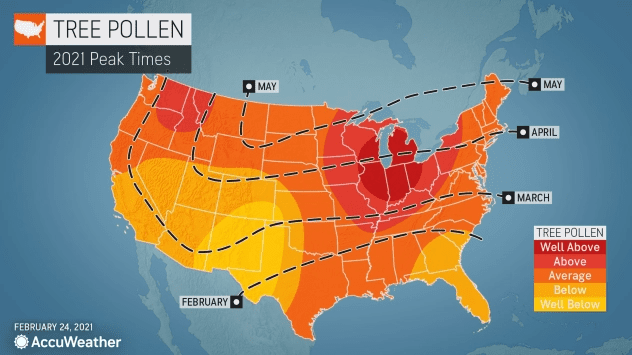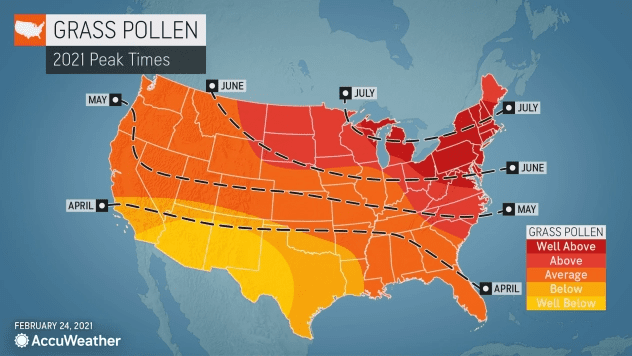Spring is creeping up fast in the United States, and that means warmer weather is on the horizon after a rough winter in some regions, but for those who suffer from seasonal allergies, there may only be a few weeks left in some parts of the country before allergens begin to kick into full gear. And one part of the nation is already beginning to feel the effects of the spring pollen season.
New research from Germany suggests that climate change is now causing allergy season to last longer, as rising temperatures are causing plants to bloom earlier, and pollen from early-blooming locations are traveling into later-blooming locations, UPI recently reported.
AccuWeather meteorologists, led by Senior Meteorologist Alan Reppert, released their annual spring allergy forecast this week, after digging into the data and exploring which areas of the country may experience an early or extended season as well as which areas could face higher-than-usual pollen counts.
Simply put, different allergens will begin to affect Americans at different points in the season, depending on the region and the weather conditions. AccuWeather forecasters have you covered on where in the U.S. allergy sufferers may need to stock up on tissues — and keep the windows closed at times this upcoming season.
“Spring by definition usually involves tree pollens … trees tend to be dominant in the spring, summer tends to be dominated by grass pollens and fall tends to be dominated by mostly weeds and some molds,” Jody Tversky, assistant professor and former clinical director of the Division of Allergy and Clinical Immunology at Johns Hopkins University, told AccuWeather.
March and April are typically when tree pollen begins to take off in the U.S. People with oak, maple, birch, elm, sycamore and hickory allergies in the mid-Atlantic region of the U.S. will begin to feel their allergies come on this month.
“By the time we reach summer, the trees are in full bloom, and you can tell this when you go to your car and you see these pollen grains on your windshield,” Tversky said. The pollen grains people see building up are too large to actually be the cause of people’s allergy symptoms, but they do signal that allergy-causing pollen is in the air.
Tree pollen forecast
The Southeast is already beginning to experience the first effects of allergy season. Trees around the Gulf Coast in particular, Reppert said, have begun releasing pollen.
Tree pollen counts for the Northeast are forecast to be around average for most of the region this year, with some above-average tree pollen forecast for the area surrounding the Great Lakes beginning in mid-March and extending through April.
This season could end up being a nasty spring season for tree-allergy sufferers in the Midwest as the weather warms up.
Midwesterners, including those who live around metropolitan areas like Chicago and Detroit, could experience some of the worst conditions for tree pollen this season.
Residents in eastern Washington, northern Idaho and eastern Oregon can also expect tree pollen to reach high levels this year.
In contrast, across the Plains, tree pollen should be on par with what is considered average for the region.
Southwest residents with tree allergies will be the only ones that will truly be able to rejoice — with an expected drought and higher-than-usual temperatures on the horizon, tree pollen counts in the region are expected to remain low throughout the season.
“Anything that does grow will be pretty quick to die off,” Reppert said. “When the grass [and] weeds dry out and have no rainfall for some time, it will actually stunt the grass and weed growth and not allow it to really grow.”
Grass and weed pollen forecasts
The mid-Atlantic and Northeast can expect above-average grass pollen counts to move into the region beginning in late May for points farther south and through June and July for points farther to the north. Several states will have some of the highest grass pollen counts in the nation this year, Reppert said.
The highest above-average pollen counts will be focused in the northernmost portion of Virginia into southern Maine. The Great Lakes region, including Michigan, northern Ohio, as well as northwestern parts of Pennsylvania and western New York, will all experience higher-than-average grass pollen counts.
Grass pollen could also spell trouble for the northernmost part of the Midwest, most prominently in Michigan, Ohio and parts of Wisconsin. The eastern half of the region can expect above-average weed pollen levels, while the western half will experience normal levels.
Above-normal levels of grass pollen are forecast to extend into the northern Plains, but the rest of the region should align with levels typically observed in the region.
Grass pollen is forecast to come in with near-normal counts for Nevada, Utah and Colorado but will be well below the average for other parts of the Southwest this year, such as across New Mexico, Arizona and western Texas.
Spring allergy sufferers in the Southeast could be facing a double whammy this year. Forecasters not only expect above-average grass pollen levels across the region, but also weed pollen counts are predicted to reach well above average during allergy season.

















